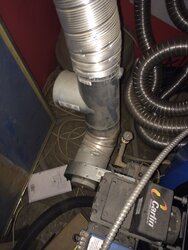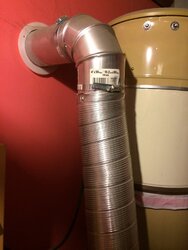I discovered early on that we have some issues with negative pressure. Our woodstove is in a large, finished room in our basement. In an adjacent room (shop and utility area) is our forced-air oil furnace, which exhausts to the outside via a power vent (vents to about 16" above ground level). There is a door between these rooms. To start our woodstove, I have to make sure the furnace is not running, and open a window until I get a good fire (draft) going. Have been doing this for several years now, and have it down to a science, so that if I follow these steps, I rarely have a start-up issue. The chimney for the stove extends the full height of our 2 story house, plus another 4' or so, and has an insulated SS liner. We have the stove and chimney cleaned regularly. We have the furnace and vent cleaned regularly.
This winter, following a couple of really cold nights, we had heavy frost on the stove pipe inside the basement. This was on nights we were NOT using the woodstove. In talking with a friend who is a home builder, he suspected that our furnace/power vent is creating enough neg pressure in the basement to pull air down the chimney, and created the frost issue. Why this never happened before I can't explain?
More recently, we had the CO detector going off on the second floor. This was 2-3 days after we had used the woodstove and had let the fire go out. Our CO detector gives a digital readout, and I traced the issue to the basement room where our woodstove is located. Investigating the stove, I found there were still a lot of hot coals/embers under the ashes. It seems they were smoldering but not making enough heat to create a draft strong enough to counter the neg pressure. The CO issue has never happened before. Only once did we get a smoky backpuff a day after burning, that was several years ago and I attributed it to the weather. It hadn't happened since.
Our contractor friend has suggested a fresh air kit for the furnace, so that it draws most air it needs from outside, thinking this would eliminate the negative pressure. Our furnace service tech says we should avoid that as it may violate our oil price/service contract. He suggested an OAK for the woodstove. So my big question is, would an OAK for the stove be enough to eliminate the negative pressure being created by the furnace and power vent in the next room?
This winter, following a couple of really cold nights, we had heavy frost on the stove pipe inside the basement. This was on nights we were NOT using the woodstove. In talking with a friend who is a home builder, he suspected that our furnace/power vent is creating enough neg pressure in the basement to pull air down the chimney, and created the frost issue. Why this never happened before I can't explain?
More recently, we had the CO detector going off on the second floor. This was 2-3 days after we had used the woodstove and had let the fire go out. Our CO detector gives a digital readout, and I traced the issue to the basement room where our woodstove is located. Investigating the stove, I found there were still a lot of hot coals/embers under the ashes. It seems they were smoldering but not making enough heat to create a draft strong enough to counter the neg pressure. The CO issue has never happened before. Only once did we get a smoky backpuff a day after burning, that was several years ago and I attributed it to the weather. It hadn't happened since.
Our contractor friend has suggested a fresh air kit for the furnace, so that it draws most air it needs from outside, thinking this would eliminate the negative pressure. Our furnace service tech says we should avoid that as it may violate our oil price/service contract. He suggested an OAK for the woodstove. So my big question is, would an OAK for the stove be enough to eliminate the negative pressure being created by the furnace and power vent in the next room?



